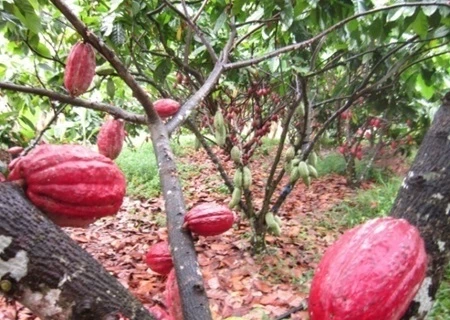HCM City (VNA) – Vietnam’s cocoa sector should aim its sights at the premium chocolate market, the director of the Internatioanl Cocoa Organisation’s (ICCO) economics and statistics division has urged.
Speaking at the second Cocoa Revolution conference held in HCM City yesterday, Laurent Pipitone said that an ICCO panel of experts on Fine Flavour Cocoa recommended that Vietnam’s cocoa production be considered as having a fine flavor cocoa origin.
There is a huge price differences between fine flavor cocoa and ordinary cocoa. While ordinary cocoa is priced between 2,800 and 3,300 USD per metric tone, the fine flavor cocoa niche can fetch up to 5,000 USD per metric tonne, with high-grade cocoa commanding prices of up to 12,000 USD per metric tonne.
Demand for dark chocolate and fine flavor cocoa has risen dramatically, especially in Europe and the US, he said.
The direction now for Vietnam is the focus on the quality for the premium chocolate market, he said.
“You need to develop the volume of quality cocoa to have a bigger market share, which requires more investment to create larger cocoa estates,” Pipitone said.
Gricha Safarian, managing director of Puratos Grand-Place Vietnam, said the company had focused on improving quality as well as post-harvesting and fermentation over the last five years.
In 2013, the company received an award for the best cocoa in the Asia Pacific region in Paris for the cocoa beans grown in Ben Tre, the southern province of Vietnam. Beans are expected to be classified as fine flavor cocoa by the ICCO, according to Safarian.
“We are the only chocolate company worldwide doing its own fermentation. Most companies buy fermented beans from farmers, “ Safarian said. “That’s why we have control of the fruity aroma in the Vietnamese bean.”
The opening of a fermentation plant was one of the last steps taken to achive full vertical integration from cocoa beans to chocolate bars, he said.
Asked about the sustainability of the sector, Safarian said:”I think we need to combine the actiob of the private sector and the Government, taking into account the interest of all stakeholders, including farmers, the industry and the Government. We’d like more land allocation for cocoa. On our side, we’re working hard to improve farmers’ income through higher yields and prices.”
The cocoa industry has had support from the private sector, including form the Ditch government-funded PPP (public-private-partnership) project for sustainable Cocoa in Vietnam, which aligns public efforts with those by Mars, Puratos Grand-Palace , the Ministry of Agriculture and Rural Development, IDH and HELVETAS.
Phan Huy Thong, director of the National Agriculture Extension Centre and Head of the Vietnam Cocoa Committee, said the cocoa sector had not had stable development in the past decade, despite encouraging results.
The country has 11,200 hectares under cocoa cultivation, with productivity remaining low at an average of 0.85 tonnes of dry bean per hectare because of plant density, improper shade management, and lack of investment in fertilisers and pest control.
The Government has taken steps to improve infrastructure, expand training and strengthen linkages between stakeholders in the value chain.
This year, the ICCO expects a supply deficit for beans, which would offer cocoa-growing countries opportunities.
With nearly 50,000 hectares of coconut and fruit trees in the Mekong Delta, and about 100,000 hectares of cashew nut trees in the southeast and Highlands regions, there is huge potential to expand cocoa cultivation in Vietnam, Thong said.-VNA























